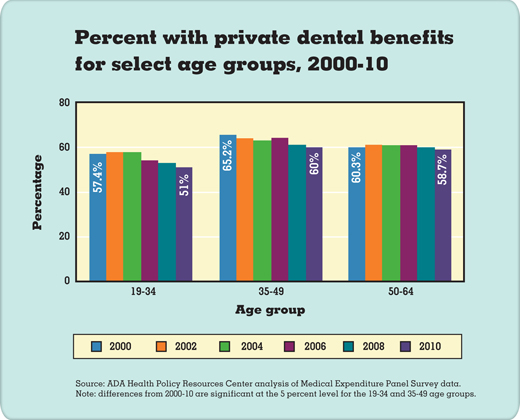Affordable Care Act falls short, ADA research says
The Affordable Care Act falls short in lowering dental care costs, increasing access to care and improving health outcomes, according to research briefs published by the ADA Health Policy Resources Center.
But state governments can pick up where the federal government left off, particularly when it comes to providing dental benefits for adults, HPRC said. Most state Medicaid programs currently provide no or limited dental benefits for adults; something state governments can change if they wanted to, HPRC said. Dental coverage for children is a required benefit under state Medicaid and the State Children’s Health Insurance Program, but states are not required to provide benefits for adults. In the past decade, adult dental benefits within Medicaid have been scaled back along with a decline in the percent of adults with private dental benefits.
“Taken together, our findings should raise concern among oral health advocates. Despite the fact that the mouth is the gateway to the body and oral health is a key part of whole body health, the Affordable Care Act fails to address critical access to dental care issues in the United States,” said Marko Vujicic, Ph.D., managing vice president of HPRC.
 |
HPRC published three research briefs that looked at how the Affordable Care Act will affect dental benefits: “Dental Benefits to Expand for Children, Likely Decrease for Adults in Coming Years;” Affordable Care Act Expands Dental Benefits for Children but Does Not Address Critical Access to Dental Care Issues;” and “Accountable Care Organizations Present Key Opportunities for the Dental Profession.” Some highlights from the research briefs:
• The Affordable Care Act will bring dental benefits to more children. About 8.7 million children are expected to gain some form of dental benefits by 2018 as a result of the new health care law. Roughly one-third will gain Medicaid dental coverage and two-thirds will gain private dental coverage through health insurance exchanges and employer-sponsored plans. Combined, this will reduce the number of children who lack dental benefits by approximately 55 percent.
• Nearly 18 million adults will gain some level of dental benefits from the Affordable Care Act, but only 4.5 million of these adults are expected to gain extensive dental benefits through Medicaid. An additional 800,000 are expected to gain private dental benefits through health insurance exchanges. Combined, about 5 percent fewer adults will be without dental benefits.
• These increases will put pressure on the Medicaid system by generating an additional 10.4 million dental visits each year through Medicaid by 2018.
• There is strong evidence that reforming Medicaid and increasing reimbursement rates to market levels would increase access to dental care. The Affordable Care Act does not do enough to address or solve administrative inefficiencies or low dental provider reimbursement levels seen at the state level.
“Historically, the issue of low provider reimbursement in Medicaid has not been unique to dentistry,” Dr. Vujicic said. “But the ACA explicitly addresses this issue for physicians by mandating increases in Medicaid fees for primary care services to bring them on par with Medicare. As a result, Medicaid reimbursement rates for physicians will be going up by an average of 73 percent, according to a study by the Kaiser Family Foundation. The act did not call for a similar adjustment to reimbursement rates for dental providers, despite the fact that pediatric dental benefits are mandated under the ACA and an influx of new Medicaid patients is expected.”
• Accountable care organizations could help bridge the gap between oral and general health care, improve coordination of dental care and help reduce overall health care costs. Dental care is not generally included as a core component within today’s ACOs, but this is largely due to the current focus on Medicare populations. Hennepin Health in Hennepin County, Minn., is one example of an accountable care organization that has incorporated dental care into its core basket of services.
“Through their analyses, the HPRC has made compelling case on the need to act now to address the oral health care crisis facing tens of millions of Americans,” said ADA President Robert A Faiella. “We are committed to creating and sustaining actionable solutions that provide care now to people in need, prevent disease from occurring or recurring and provide people with the knowledge that empowers them to be good stewards of their own oral health.”
The ADA plans to announce a new initiative May 15 aimed at addressing the access to care issue.
Parts of the Affordable Care Act, which was signed into law by President Obama in 2010, have already been implemented with the full health care bill going into effect by 2014.
“More and more adults are experiencing financial barriers to dental care. The rate of hospital emergency room visits for preventable dental conditions has increased among adults, unnecessarily driving up the cost to the health care system,” Dr. Vujicic said. “Urgent action is needed to reverse these trends and, unfortunately, the ACA did not take the bold steps needed The bright spot is that there is plenty of opportunities for states, employers, individuals and dental care providers to pick up where the ACA left off.”
To read the full research briefs, visit here.
